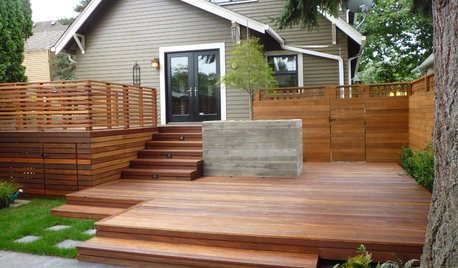Need privacy under high-skirted cedars
beckyhowie
11 years ago
Related Stories

WOODKnotty and Nice: Highly Textured Wood Has a Modern Revival
Whether it's cedar, fir or pine, if a wood has a knot, it's hot
Full Story
LANDSCAPE DESIGNThe 7 Best Plant Types for Creating Privacy and How to Use Them
Follow these tips for using different kinds of plants as living privacy screens
Full Story
REMODELING GUIDESDesign Dilemma: How Do I Modernize My Cedar Walls?
8 Ways to Give Wood Walls a More Contemporary Look
Full Story
GARDENING AND LANDSCAPINGGrow a Lush Privacy Screen
No need to wait forever for patio privacy the green way. These 10 ideas will get your screening up and running in no time
Full Story
GARDENING GUIDESGrow Your Own Privacy: How to Screen With Plants and Trees
Use living walls to lower your home and garden's exposure while boosting natural beauty in your landscape
Full Story
CURB APPEALEntry Recipe: Warmth, Style and Privacy in Toronto
A front porch dominated by wood and glass rises and pivots toward a side courtyard sheltered from street traffic
Full Story
FURNITUREObjects of Desire: File These Secretary Desks Under ‘Gorgeous’
Space saving and ever functional, these fold-up desks are raising the bar for home offices and work nooks everywhere
Full Story
GARDENING AND LANDSCAPINGThat Gap Under the Deck: Hide It or Use It!
6 ways to transform a landscape eyesore into a landscape feature
Full Story
MODERN HOMESHouzz Tour: In Washington, a Modern Beauty on the Bay
A concrete, cedar and glass contemporary Northwest home opens directly to the water
Full Story
MODERN HOMESHouzz Tour: Relaxed Living in a Modern Courtyard Home
A new Melbourne home is highlighted by a stunning cedar ceiling that soars and dips
Full Story








Embothrium
George Three LLC
Related Professionals
Hershey Landscape Architects & Landscape Designers · Lake Oswego Landscape Architects & Landscape Designers · Crystal Landscape Contractors · Fort Atkinson Landscape Contractors · Medford Landscape Contractors · Ringwood Landscape Contractors · Rio Linda Landscape Contractors · Saint Paul Landscape Contractors · Secaucus Landscape Contractors · Arcadia Fence Contractors · Chicago Fence Contractors · Gainesville Fence Contractors · Grover Beach Fence Contractors · Homestead Fence Contractors · Brookhaven Outdoor Lighting & Audio Visual Systemslarry_gene
botann
bejoy2
botann
beckyhowieOriginal Author
plantknitter
Embothrium
gardengal48 (PNW Z8/9)
Embothrium
bejoy2
gardengal48 (PNW Z8/9)
bejoy2
Embothrium
larry_gene
botann
Embothrium
gardengal48 (PNW Z8/9)
Embothrium
botann